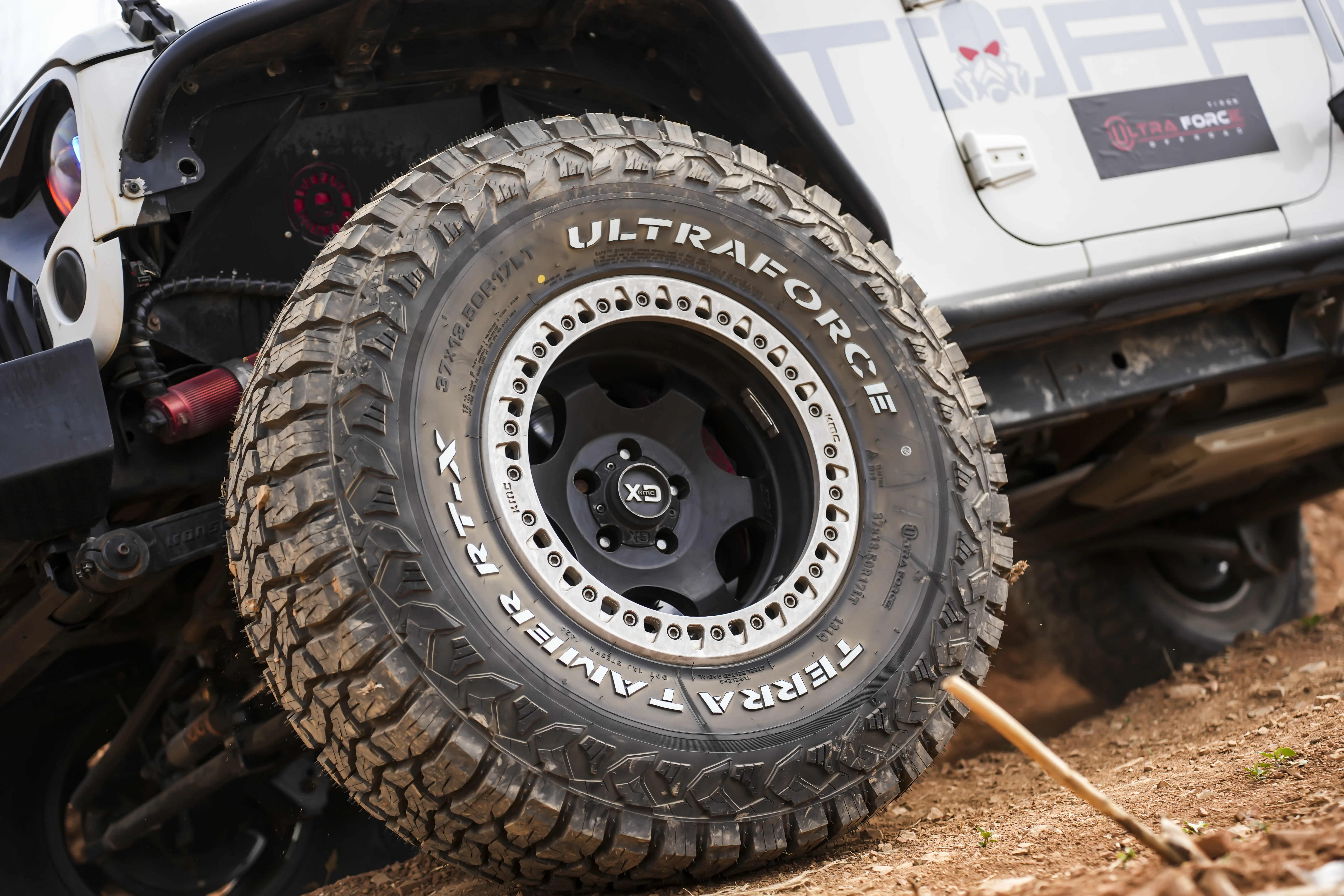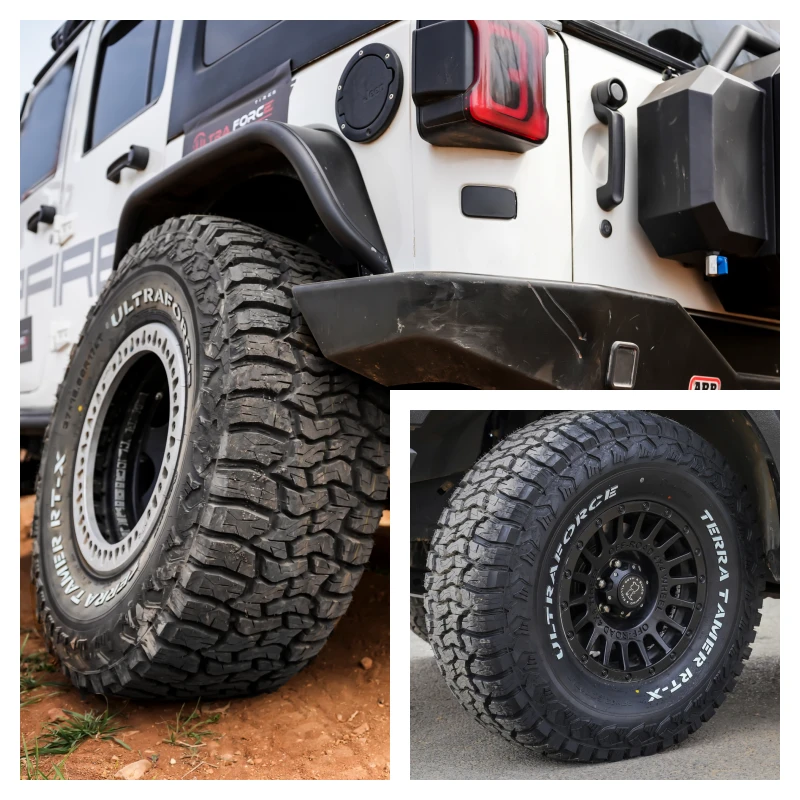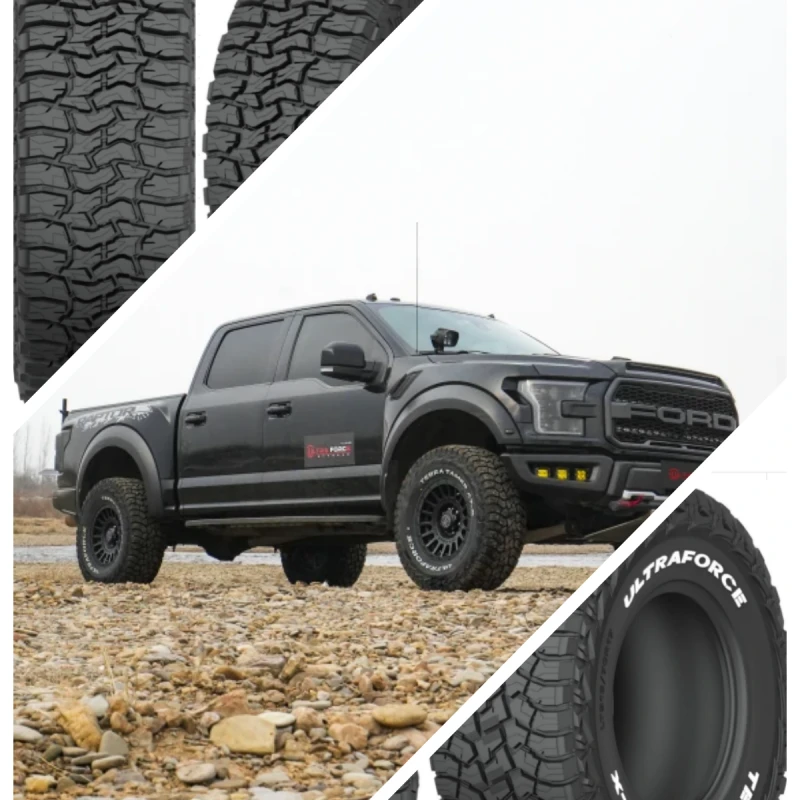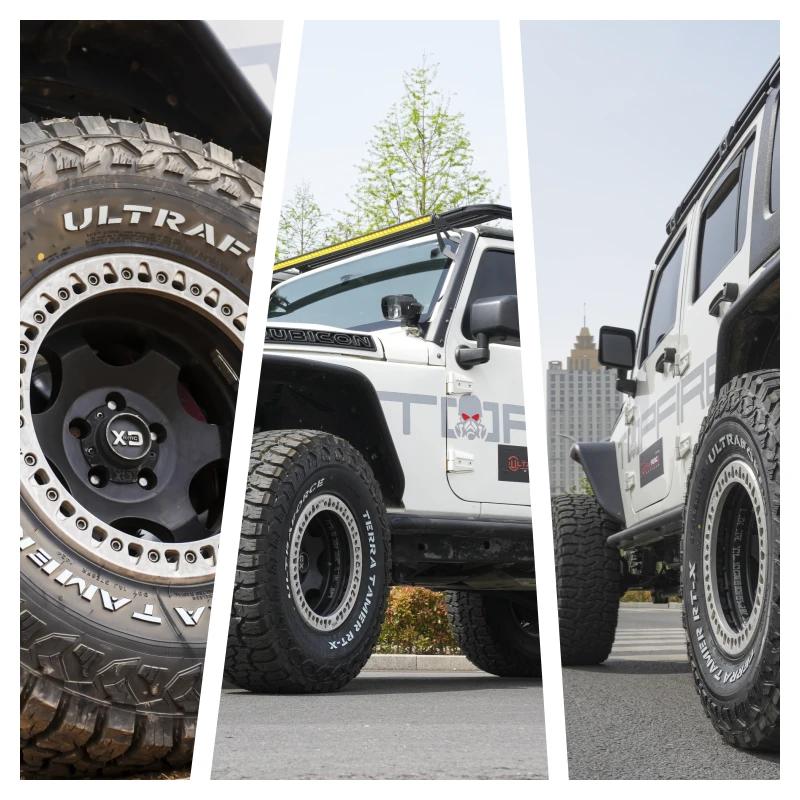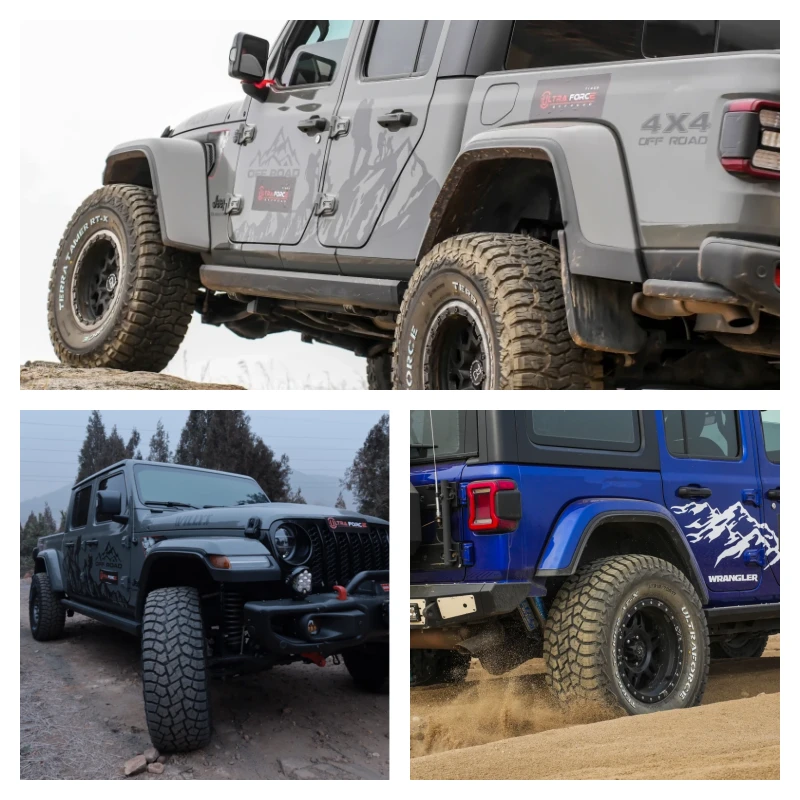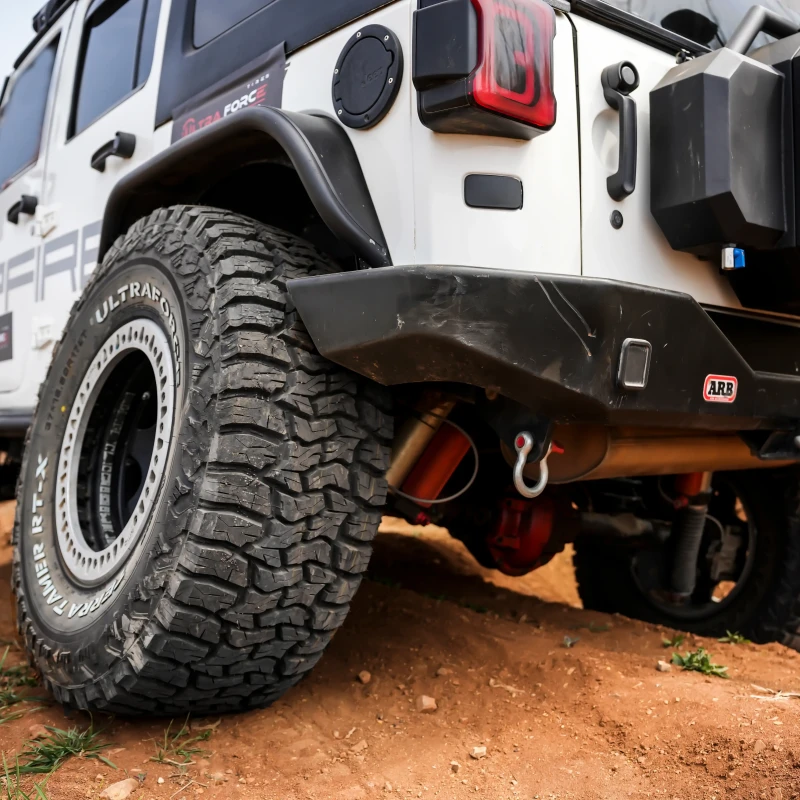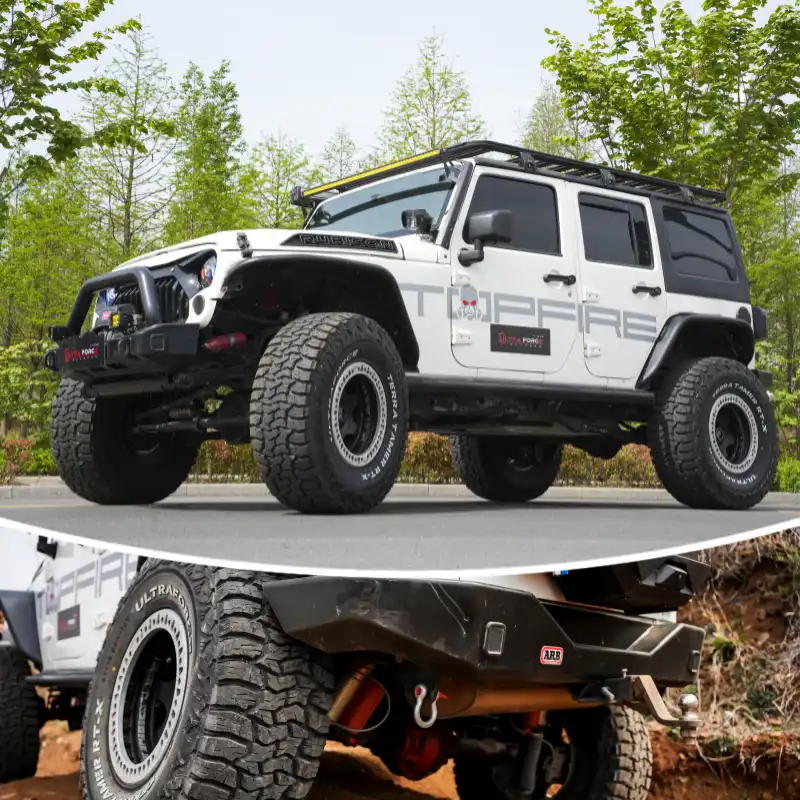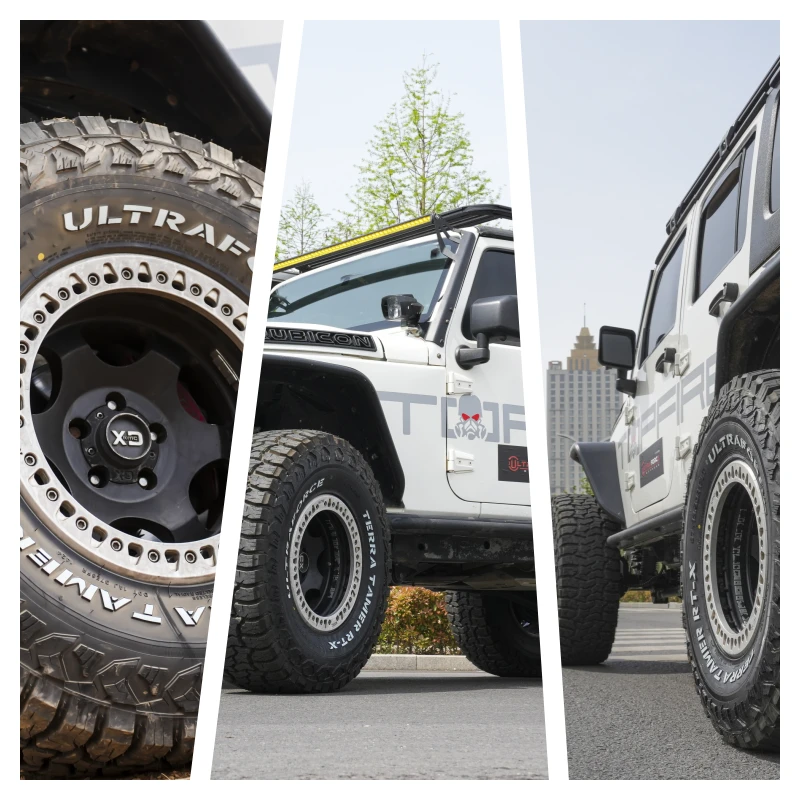Off-Road Tires That Are Good On-Road: Striking the Perfect Balance
Off-road enthusiasts understand the thrill and challenge of navigating rugged terrains, muddy trails, and rocky paths. For these adventures, specialized off-road tires are indispensable. However, many off-road vehicles also serve as daily drivers, necessitating a tire that can handle both rugged landscapes and smooth highways with equal aplomb. This dual-purpose demand has led to the development of off-road tires that perform exceptionally well on-road, combining durability, traction, and comfort. This article explores the characteristics, benefits, and top choices of off-road tires that excel in on-road performance.
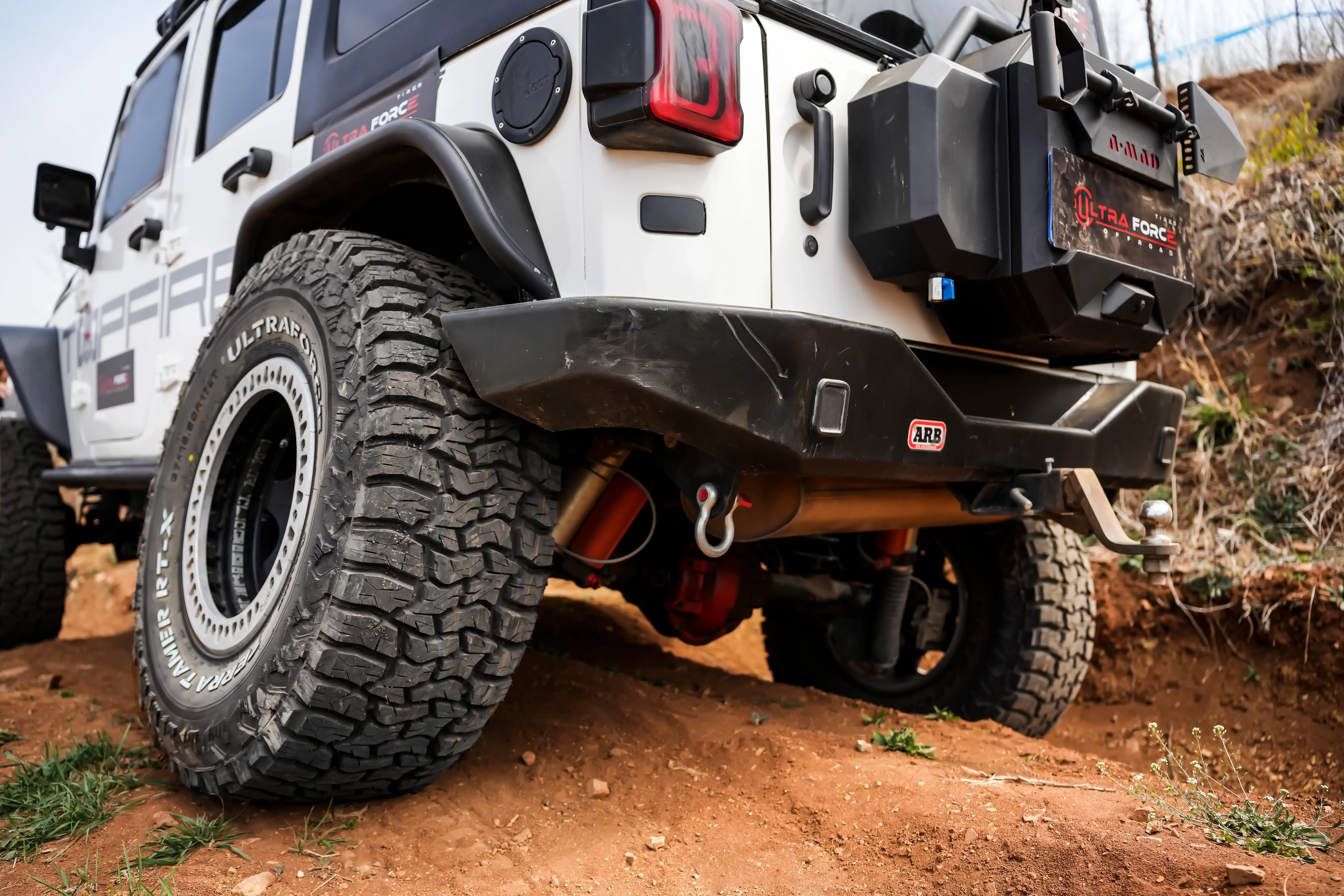
Characteristics of Dual-Purpose Tires
1. Tread Design:
- Off-road tires are known for their aggressive tread patterns designed to grip uneven surfaces. However, for on-road performance, the tread needs to be optimized to reduce noise and improve handling. Modern dual-purpose tires feature a hybrid tread design that maintains off-road capability while enhancing on-road smoothness and quietness.
2. Rubber Compound:
- The rubber compound used in the tire significantly affects its performance. Dual-purpose tires utilize a compound that balances flexibility for off-road traction and durability for on-road longevity. This means they are less prone to wear and tear from pavement driving while still providing adequate grip in off-road conditions.
3. Sidewall Strength:
- Off-road tires typically have reinforced sidewalls to resist punctures from rocks and debris. This attribute is beneficial for on-road use as well, providing additional safety and stability, especially when cornering or carrying heavy loads.
4. Heat Dissipation:
- On-road driving generates more heat, especially at high speeds. Tires that are good both off and on-road are designed to dissipate heat efficiently, preventing blowouts and extending tire life.
Benefits of Dual-Purpose Tires
1. Versatility:
- The primary advantage of dual-purpose tires is their versatility. Whether navigating city streets, highways, or backcountry trails, these tires ensure reliable performance. This versatility is particularly valuable for drivers who use their vehicles for a variety of activities, from daily commutes to weekend adventures.
2. Cost-Effective:
- Investing in a set of dual-purpose tires eliminates the need for separate off-road and on-road tires. This not only saves money but also the hassle of frequent tire changes. Moreover, the enhanced durability of these tires means fewer replacements over time.
3. Improved Safety:
- The reinforced construction and advanced design of dual-purpose tires enhance safety on all surfaces. Better traction, improved handling, and increased resistance to punctures contribute to a safer driving experience, regardless of the terrain.
4. Comfort and Noise Reduction:
- Unlike traditional off-road tires, which can be noisy and uncomfortable on pavement, modern dual-purpose tires are engineered to provide a smoother and quieter ride. This makes them ideal for daily driving, enhancing overall comfort.
Top Choices of Dual-Purpose Tires
1. BFGoodrich All-Terrain T/A KO2
BFGoodrich's All-Terrain T/A KO2 is a benchmark in the dual-purpose tire market. Known for its durability and versatility, the KO2 features:
- CoreGard Technology: Reinforced sidewalls that resist cuts and bruises from rocks and rough terrain.
- Interlocking Tread Design: Provides excellent traction and stability on both off-road and on-road surfaces.
- Stone Ejectors: Prevent stones from lodging in the tread, enhancing durability and performance.
The KO2 excels in offering a smooth and quiet ride on highways while maintaining impressive off-road capabilities.
2. Goodyear Wrangler All-Terrain Adventure with Kevlar
Goodyear's Wrangler All-Terrain Adventure tire is another top contender, blending on-road comfort with off-road toughness:
- Kevlar Reinforcement: Adds strength and puncture resistance to the tire.
- Durawall Technology: Protects the sidewalls from cuts and abrasions.
- Multi-Faceted Tread Blocks: Improve traction on various surfaces and reduce road noise.
This tire is particularly favored for its excellent grip and stability in both dry and wet conditions, making it a reliable choice for all-weather performance.
3. Falken Wildpeak A/T3W
The Falken Wildpeak A/T3W is designed for those who demand both off-road ruggedness and on-road refinement:
- Heat Diffuser Technology: Helps keep the critical areas of the tire cool, ensuring stability even when carrying heavy loads.
- Rugged and Rigid Tread Blocks: Enhance off-road traction while maintaining good on-road handling.
- 3D Canyon Sipe Technology: Improves durability and provides additional grip on wet and snowy roads.
The A/T3W is known for its durability and adaptability, performing well across a wide range of conditions.
4. Toyo Open Country A/T III
Toyo’s Open Country A/T III is a well-rounded tire that delivers balanced performance for both on-road and off-road driving:
- Aggressive Tread Design: Offers exceptional off-road traction without compromising on-road stability.
- Cut and Chip Resistant Compound: Enhances durability in rough terrains.
- Multi-Wave Sipes: Provide improved traction in wet conditions and reduce road noise.
This tire is praised for its longevity and the comfort it provides on paved roads.
5. Michelin LTX A/T2
Michelin’s LTX A/T2 is known for its superior on-road comfort and reliable off-road performance:
- MaxTouch Construction: Distributes forces evenly across the tire, enhancing tread life.
- Advanced Tread Design: Reduces noise and improves ride comfort.
- Michelin's Biting Edges: Increase traction on loose and wet surfaces.
The LTX A/T2 is ideal for those who prioritize comfort and longevity while still requiring solid off-road capabilities.
6. UltraForce A/T
UltraForce is a leading brand in the off-road tyre industry, known for its innovative design and superior performance. Specializing in tyres for off-road vehicles, UltraForce caters to the needs of adventurers, outdoor enthusiasts, and professionals who require reliable and durable tyres for challenging terrains.
Key Features and Benefits:
Robust Construction:
UltraForce tyres are built with high-quality materials that ensure durability and resistance to wear and tear. The rugged construction is designed to handle extreme conditions, providing long-lasting performance.
Innovative Tread Design:
The unique tread patterns of UltraForce tyres are engineered for optimal traction on various off-road surfaces, including mud, sand, rocks, and gravel. This design enhances grip and stability, ensuring a safer and more controlled driving experience.
Enhanced Durability:
UltraForce tyres feature reinforced sidewalls and multi-layered treads that offer exceptional puncture resistance and protection against cuts and abrasions. This makes them ideal for the most demanding off-road environments.
Superior Performance:
These tyres are designed to deliver outstanding performance in both wet and dry conditions. The advanced rubber compounds provide excellent grip and handling, ensuring maximum performance even in adverse weather conditions.
Versatility:
UltraForce offers a wide range of tyre sizes and specifications to fit various off-road vehicles, including SUVs, trucks, ATVs, and UTVs. This versatility ensures that users can find the perfect tyre for their specific vehicle and off-road needs.
Why Choose UltraForce Off-Road Tyres?
Reliability:
UltraForce tyres are rigorously tested to meet high standards of reliability and performance. Whether you’re navigating rocky trails or sandy dunes, you can count on UltraForce to get you through.
Innovation:
The brand continuously invests in research and development to bring the latest innovations to their tyre designs. This commitment to innovation ensures that UltraForce tyres remain at the forefront of off-road technology.
Customer Satisfaction:
UltraForce prioritizes customer satisfaction by offering products that combine quality, durability, and performance. Their tyres are designed to meet the expectations of off-road enthusiasts and professionals alike.
Competitive Pricing:
Despite their high quality and advanced features, UltraForce tyres are competitively priced, offering excellent value for money. This makes them accessible to a wide range of customers without compromising on performance.
Example Models:
UltraForce TrailMaster:
Designed for extreme off-road conditions, the TrailMaster features an aggressive tread pattern and reinforced sidewalls for maximum durability and traction on rugged terrains.
UltraForce SandBlazer:
Ideal for sandy and loose surfaces, the SandBlazer offers a unique tread design that enhances flotation and grip, ensuring superior performance in desert environments.
UltraForce RockCrusher:
Built for rocky and uneven terrains, the RockCrusher provides exceptional stability and puncture resistance, making it perfect for rock crawling and mountainous trails.
UltraForce Off-Road Tyres are a top choice for anyone looking to tackle challenging terrains with confidence. With their robust construction, innovative design, and superior performance, UltraForce tyres provide the reliability and durability needed for any off-road adventure. Whether you are a weekend warrior or a professional off-roader, UltraForce has the perfect tyre to meet your needs and exceed your expectations. Choose UltraForce for unmatched quality, performance, and value in off-road tyres.
Considerations for Choosing Dual-Purpose Tires
When selecting the right dual-purpose tire, several factors should be considered to ensure optimal performance:
1. Driving Habits: Evaluate the proportion of time spent on-road versus off-road. Some tires are more biased towards on-road comfort, while others prioritize off-road toughness.
2. Climate and Terrain: Consider the typical weather and terrain conditions. Tires that perform well in snow and rain may be necessary in certain regions, while others might need enhanced heat resistance for desert environments.
3. Vehicle Type: The make and model of the vehicle can influence the best tire choice. Heavier trucks may require tires with higher load ratings, while lighter SUVs might benefit from different tread designs.
4. Load Capacity: Ensure the tires can handle the weight of the vehicle and any additional loads. This is crucial for safety and performance, particularly when carrying heavy gear or towing.
5. Noise and Comfort: If the vehicle is used frequently for long drives on highways, selecting a tire that minimizes road noise and enhances ride comfort is important.
Maintenance Tips for Dual-Purpose Tires
To maximize the lifespan and performance of dual-purpose tires, regular maintenance is essential:
1. Regular Inspections: Check for cuts, punctures, and uneven wear. Address any issues promptly to prevent further damage.
2. Proper Inflation: Maintain the recommended tire pressure to ensure optimal performance and safety. Under-inflation or over-inflation can lead to poor handling and increased wear.
3. Balanced and Aligned: Regularly balance and align the tires to prevent uneven wear and improve handling.
4. Rotate Tires: Follow the manufacturer's recommendations for tire rotation to ensure even wear across all tires.
5. Clean Tires: After off-road adventures, clean the tires to remove mud, stones, and debris that can cause damage over time.
What Are The Key Features To Look For In Off-Road Tires That Perform Well On-Road?
When selecting off-road tires that perform well on-road, several key features are essential to ensure you get the best of both worlds: rugged off-road capabilities and smooth on-road performance. Understanding these features will help you make an informed decision.
1. Tread Design
The tread design is crucial for dual-purpose tires. Off-road tires typically have aggressive, deep treads designed to provide maximum grip on loose and uneven surfaces. However, this can lead to increased road noise and reduced comfort on paved roads. Look for a hybrid tread design that balances these needs. Such designs usually feature interlocking tread blocks that provide off-road traction while minimizing noise and improving handling on highways.
2. Rubber Compound
The rubber compound of the tire determines its flexibility and durability. For dual-purpose tires, the compound should offer a balance between softness for off-road traction and hardness for on-road longevity. Tires with a specialized compound that resists cuts and abrasions while maintaining flexibility in various temperatures are ideal. This ensures the tires can handle rough terrains and still perform well on pavement.
3. Sidewall Strength
Off-road driving subjects tires to sharp rocks, debris, and other hazards that can damage sidewalls. Reinforced sidewalls with technologies like Kevlar or other strong materials are essential. These reinforcements provide puncture resistance and additional stability, which is also beneficial for on-road driving, particularly when cornering or carrying heavy loads.
4. Heat Dissipation
On-road driving, especially at high speeds, generates significant heat. Tires designed for dual-purpose use should have features that aid in heat dissipation to prevent blowouts and extend tire life. Look for tires with advanced cooling technologies or designs that manage heat effectively, ensuring safe and reliable performance on highways.
5. All-Weather Capability
Weather can greatly affect tire performance. Dual-purpose tires should perform well in a variety of weather conditions, including rain, snow, and mud. Features like multiple sipes (small slits in the tread blocks) can improve grip on wet and snowy roads. Additionally, tires rated for all-season use provide better performance in diverse climates, enhancing safety and versatility.
6. Load Capacity
Consider the load-carrying capacity of the tires. Off-road vehicles often carry heavy equipment or tow trailers, so the tires must handle the weight. Check the load rating of the tire to ensure it meets your needs without compromising performance or safety. Higher load ratings often come with reinforced structures that also contribute to better on-road stability.
7. Noise and Comfort
Traditional off-road tires can be noisy and uncomfortable on paved roads. Modern dual-purpose tires incorporate noise-reduction technologies and design elements that provide a quieter and smoother ride. This includes features like variable pitch tread patterns that disrupt the noise frequency and optimized tread blocks that enhance ride comfort.
8. Durability and Wear
Durability is a critical factor, as dual-purpose tires should withstand the rigors of off-road driving and the wear of on-road use. Look for tires with advanced wear-resistant compounds and designs that promote even tread wear. This not only extends the life of the tires but also maintains consistent performance over time.
In summary, the ideal off-road tire that performs well on-road should have a hybrid tread design, a balanced rubber compound, reinforced sidewalls, effective heat dissipation, all-weather capability, adequate load capacity, noise and comfort optimization, and high durability. These features ensure that the tires can handle the demands of both rugged trails and smooth highways, providing versatility and reliability for your vehicle.
How Do Off-Road Tires That Are Good On-Road Improve Vehicle Safety?
Off-road tires that perform well on-road can significantly enhance vehicle safety in various ways. These dual-purpose tires are engineered to provide reliable performance across diverse driving conditions, ensuring that drivers and passengers are safe whether they are navigating city streets or tackling rugged terrains.
1. Enhanced Traction
One of the primary safety benefits of these tires is improved traction. The hybrid tread design of dual-purpose tires features interlocking tread blocks and multiple sipes, which enhance grip on both loose off-road surfaces and smooth pavements. This increased traction is crucial for maintaining control in various driving conditions, including wet or snowy roads, thereby reducing the risk of skidding or losing control.
2. Reinforced Sidewalls
Dual-purpose tires often have reinforced sidewalls made with materials like Kevlar, providing added protection against punctures and cuts from sharp rocks and debris encountered off-road. This reinforcement also benefits on-road safety by enhancing the tire's structural integrity. Reinforced sidewalls offer better stability during cornering and heavy load carrying, which is essential for maintaining control and preventing accidents.
3. Heat Dissipation
On-road driving, especially at high speeds, generates significant heat. Tires designed for dual-purpose use incorporate features that help dissipate heat, preventing overheating and potential blowouts. Efficient heat management ensures that the tires remain in good condition, even during extended highway drives, thus reducing the risk of sudden tire failure and improving overall safety.
4. All-Weather Performance
Safety on the road can be heavily influenced by weather conditions. Dual-purpose tires are designed to perform well in various weather conditions, including rain, snow, and mud. The presence of multiple sipes and specialized tread patterns enhances grip on wet and icy roads, reducing the likelihood of hydroplaning. Additionally, tires rated for all-season use provide consistent performance throughout the year, ensuring safe driving in diverse climates.
5. Load Handling
Off-road vehicles often carry heavy equipment or tow trailers, requiring tires that can handle substantial loads. Dual-purpose tires are built with high load ratings and reinforced structures to manage heavy weights without compromising safety. Proper load handling prevents tire deformation, maintains vehicle balance, and ensures stable handling, which is crucial for preventing accidents, especially when carrying heavy loads.
6. Noise Reduction and Comfort
Excessive road noise and discomfort can be distracting for drivers, potentially affecting their focus and reaction times. Dual-purpose tires incorporate noise-reduction technologies and comfort-enhancing features, such as variable pitch tread patterns and optimized tread blocks. These elements provide a quieter and smoother ride, helping drivers stay alert and comfortable, which is essential for safe driving.
7. Durability and Consistent Performance
Durability is a key factor in tire safety. Dual-purpose tires are designed with advanced wear-resistant compounds and features that promote even tread wear. This ensures that the tires maintain their performance characteristics over time, providing reliable traction, stability, and handling. Consistent performance reduces the risk of unexpected tire failure and ensures that the vehicle handles predictably in all conditions.
8. Puncture Resistance
The reinforced construction of dual-purpose tires includes features that resist punctures from off-road debris, such as sharp rocks and sticks. This puncture resistance translates to increased on-road safety, as the tires are less likely to suffer sudden air loss from road hazards. Maintaining proper tire pressure and avoiding unexpected deflation are crucial for safe driving, particularly at high speeds.
In conclusion, off-road tires that are good on-road improve vehicle safety through enhanced traction, reinforced sidewalls, efficient heat dissipation, all-weather performance, load handling capabilities, noise reduction, durability, and puncture resistance. These features collectively ensure that the tires provide reliable and consistent performance in a variety of driving conditions, keeping drivers and passengers safe on both rugged trails and smooth highways.
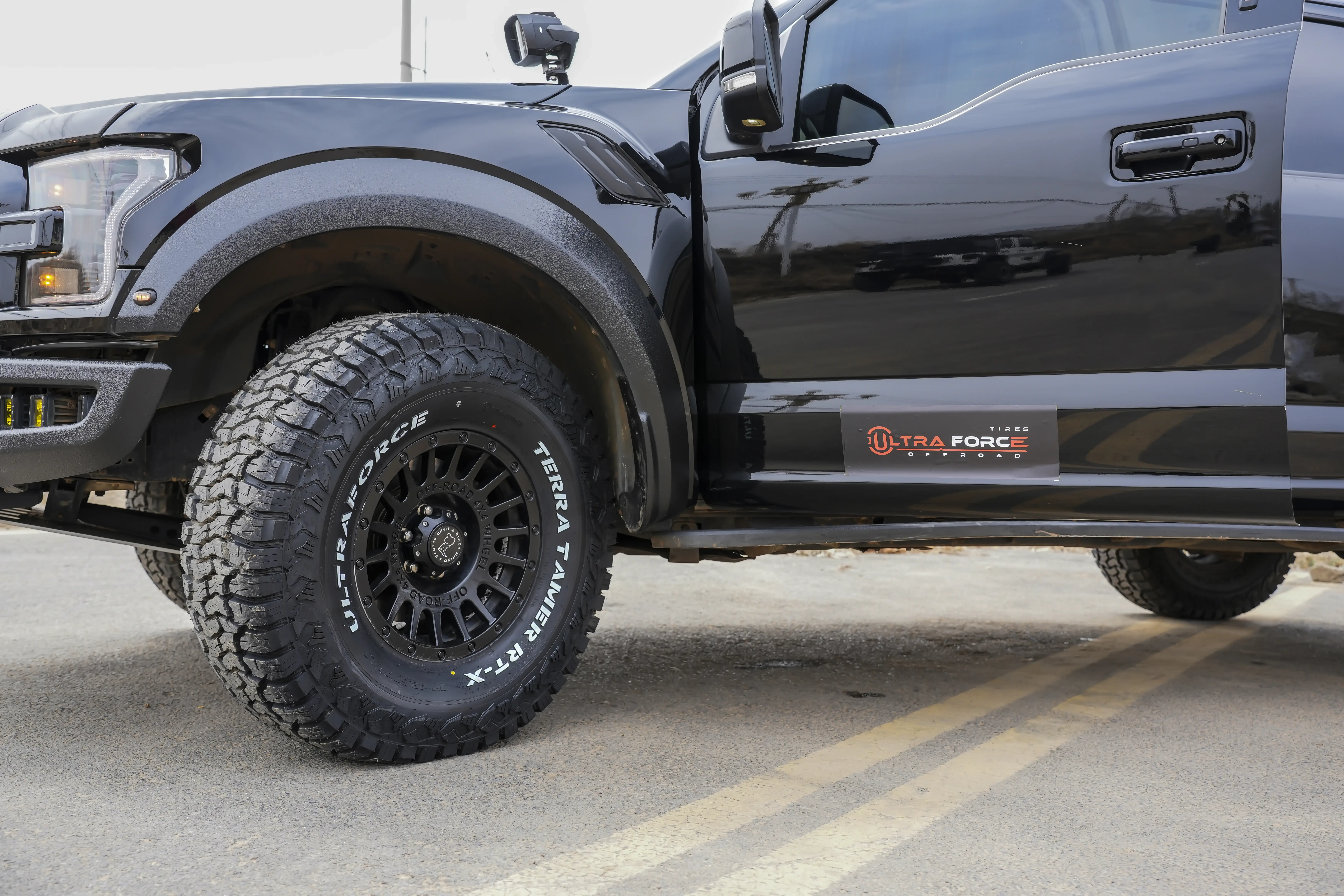
What Are The Best Maintenance Practices For Dual-Purpose Tires To Ensure Longevity And Performance?
Maintaining dual-purpose tires properly is crucial for ensuring their longevity and optimal performance. These tires are designed to handle the demands of both off-road and on-road driving, but they require regular attention and care to perform at their best. Here are some of the best maintenance practices for dual-purpose tires:
1. Regular Inspections
Frequent visual inspections are essential to identify any cuts, punctures, or unusual wear patterns. Look for embedded stones, nails, or other debris that could damage the tires. Checking the sidewalls for cracks or bulges is also important, as these can indicate potential issues that need addressing.
2. Proper Inflation
Maintaining the correct tire pressure is critical for both performance and safety. Under-inflated tires can lead to poor handling, increased wear, and a higher risk of blowouts, while over-inflated tires can cause a harsh ride and uneven tread wear. Use a reliable tire pressure gauge to check the pressure regularly, ideally once a month and before any long trips. Refer to the vehicle’s owner’s manual or the tire manufacturer’s guidelines for the recommended pressure levels.
3. Tire Rotation
Rotating your tires regularly helps ensure even wear across all tires, which extends their lifespan and maintains balanced handling. It’s generally recommended to rotate tires every 5,000 to 7,000 miles, but consult your vehicle’s manual for specific guidance. Proper rotation patterns (front-to-back, cross, etc.) depend on whether you have directional or non-directional tires.
4. Wheel Alignment
Misaligned wheels can cause uneven tire wear and affect vehicle handling. It’s advisable to have the wheel alignment checked periodically, especially if you notice the vehicle pulling to one side, uneven tire wear, or after hitting a significant pothole or obstacle. Proper alignment ensures that your tires wear evenly and your vehicle handles correctly.
5. Balancing Tires
Unbalanced tires can lead to vibrations, uneven wear, and strain on suspension components. Whenever you install new tires or if you experience vibrations at certain speeds, have your tires balanced. Balancing involves adding small weights to the wheel to ensure even weight distribution around the tire.
6. Cleaning Tires
After off-road adventures, clean your tires thoroughly to remove mud, stones, and other debris. Stuck debris can cause damage over time and affect tire performance. Use water and a mild detergent to clean the tires, and avoid harsh chemicals that could degrade the rubber.
7. Monitor Tread Depth
Tread depth is crucial for maintaining grip and preventing hydroplaning. Use a tread depth gauge to measure the depth regularly. Most tires have tread wear indicators (small raised bars in the grooves) that show when the tread is worn down to the legal limit. Replace tires when they reach the minimum tread depth, typically 2/32 of an inch, but consider replacing them earlier for better safety and performance.
8. Storage Practices
If you store your vehicle or spare tires for an extended period, ensure they are stored properly to prevent degradation. Store tires in a cool, dry place away from direct sunlight, heat sources, and chemicals. Keep them off the ground and covered to protect them from dust and debris. If possible, store tires vertically to prevent flat spots.
9. Driving Habits
Your driving habits can significantly affect tire wear. Avoid aggressive driving, such as hard cornering, rapid acceleration, and sudden braking, which can cause premature wear. Drive at moderate speeds and handle your vehicle smoothly to extend tire life.
10. Load Management
Overloading your vehicle can strain your tires and cause excessive wear. Always adhere to the manufacturer’s recommended load limits for your vehicle and tires. Distribute the load evenly to maintain balance and handling.
In summary, regular inspections, maintaining proper inflation, rotating and balancing tires, ensuring correct wheel alignment, cleaning tires, monitoring tread depth, proper storage, adopting safe driving habits, and managing loads are essential maintenance practices for dual-purpose tires. By following these practices, you can maximize the lifespan and performance of your tires, ensuring a safe and smooth driving experience both on and off the road.
How Do Dual-Purpose Tires Compare To Dedicated Off-Road And On-Road Tires In Terms Of Performance?
Dual-purpose tires are designed to bridge the gap between dedicated off-road and on-road tires, offering a balance of performance that makes them versatile for various driving conditions. Here's a detailed comparison of how dual-purpose tires stack up against their dedicated counterparts:
1. Traction and Grip
Off-Road Performance: Dedicated off-road tires are engineered with aggressive, deep tread patterns and larger voids to maximize traction on loose, uneven surfaces like mud, sand, and rocks. Dual-purpose tires, while capable of handling off-road conditions, typically have a less aggressive tread design to maintain on-road performance. This means they may not provide the same level of grip in extreme off-road scenarios but still perform adequately for moderate off-roading.
On-Road Performance: On-road tires are designed with a smoother tread pattern that maximizes contact with the road, providing superior traction on pavement. Dual-purpose tires incorporate a hybrid tread design that balances the need for off-road grip with on-road traction, offering a compromise that performs well in both environments.
2. Durability and Wear
Off-Road Durability: Dedicated off-road tires are built to withstand the rigors of rugged terrains, with reinforced sidewalls and robust construction to resist punctures, cuts, and abrasions. Dual-purpose tires also feature reinforced sidewalls but are designed to endure both off-road and on-road wear, making them slightly less specialized but more versatile.
On-Road Wear: On-road tires are optimized for longevity and smooth performance on paved surfaces, with compounds that resist wear from highway driving. Dual-purpose tires use a balanced rubber compound that provides durability for both on-road and off-road conditions. While they may not last as long as dedicated on-road tires in purely highway conditions, they offer a good compromise for mixed use.
3. Noise and Comfort
Off-Road Noise: The aggressive tread patterns of off-road tires can generate significant noise and vibration when used on paved roads, leading to a less comfortable ride. Dual-purpose tires are designed to reduce noise with hybrid tread patterns that are quieter and smoother on pavement while still providing adequate off-road performance.
On-Road Comfort: On-road tires are engineered for a quiet, comfortable ride, with features that minimize road noise and vibration. Dual-purpose tires, while not as quiet as dedicated on-road tires, incorporate noise-reducing technologies and optimized tread designs to provide a comfortable ride suitable for daily driving.
4. Handling and Stability
Off-Road Handling: Dedicated off-road tires offer excellent handling on rough terrains, with features that enhance grip and stability on uneven surfaces. Dual-purpose tires provide good off-road handling but are designed to maintain stability on paved roads as well, making them less specialized but more versatile.
On-Road Stability: On-road tires excel in providing precise handling and stability on smooth surfaces, essential for high-speed driving and cornering. Dual-purpose tires are designed to balance these needs, offering stable on-road performance without sacrificing too much off-road capability.
5. Weather Performance
All-Weather Capability: Dual-purpose tires are often rated for all-season use, with tread designs and compounds that handle a variety of weather conditions, including rain and light snow. Dedicated off-road tires may not perform as well on wet or icy roads due to their specialized tread patterns, and dedicated on-road tires might lack the necessary features for effective off-road use in adverse weather.
In summary, dual-purpose tires offer a versatile solution that combines the key benefits of both dedicated off-road and on-road tires. They provide adequate traction, durability, noise reduction, handling, and weather performance for a variety of driving conditions. While they may not match the specialized performance of dedicated tires in extreme conditions, their balanced design makes them an excellent choice for drivers who need reliable performance across diverse terrains and weather conditions.
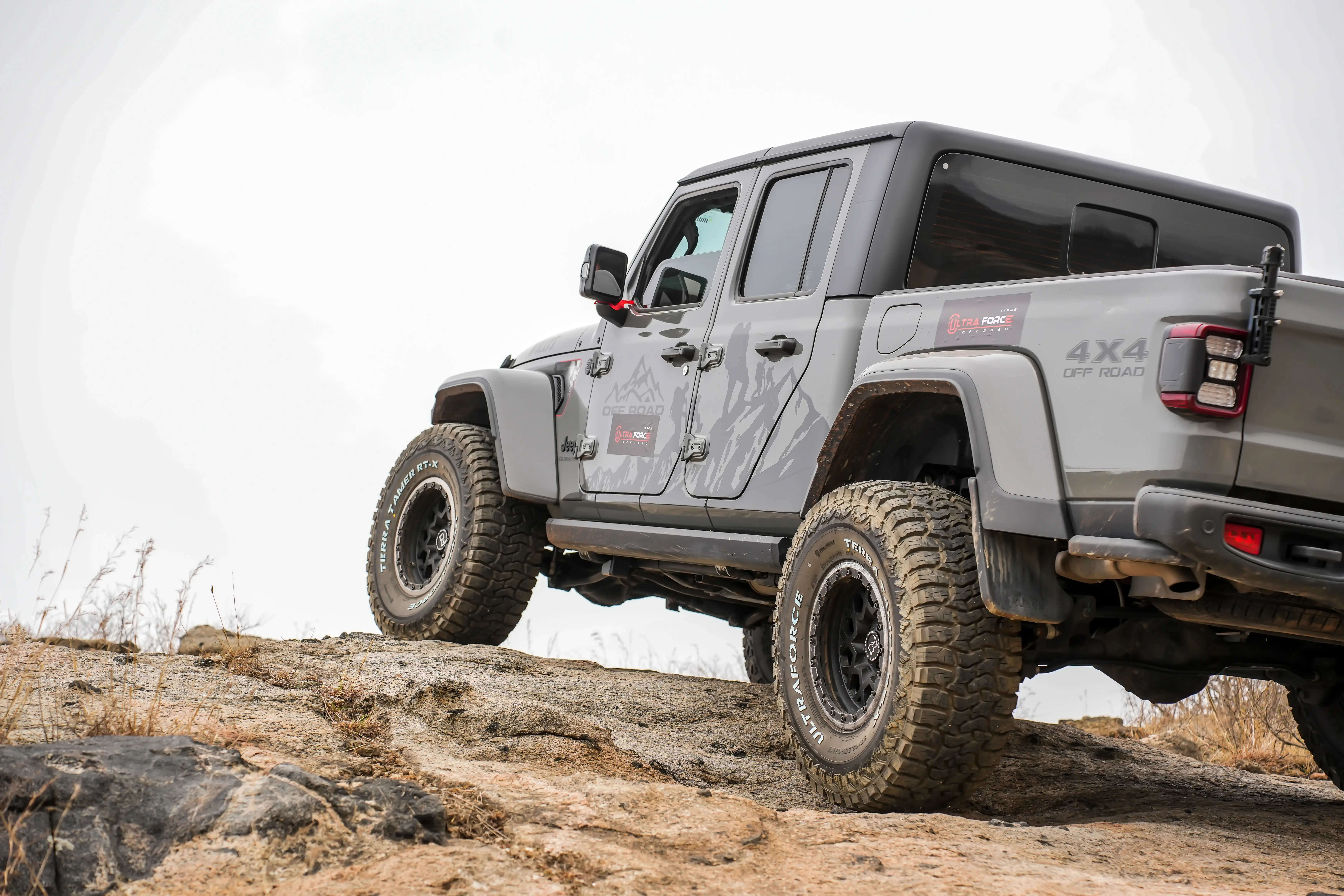
What Are The Cost Considerations When Choosing Dual-Purpose Tires?
Choosing dual-purpose tires involves several cost considerations, from the initial purchase price to long-term value. Understanding these factors can help you make an informed decision that balances performance and budget.
1. Initial Purchase Price
Tire Quality and Brand: The price of dual-purpose tires can vary significantly based on the brand and quality. Premium brands like BFGoodrich, Goodyear, and Michelin often come with higher price tags due to their advanced technology, superior materials, and extensive research and development. However, these tires also tend to offer better performance and durability, which can justify the higher upfront cost.
Size and Specifications: Larger tires and those with specific features (like higher load ratings or enhanced sidewall protection) can also be more expensive. Ensure the tires you choose are suitable for your vehicle’s specifications to avoid unnecessary expenses.
2. Durability and Longevity
Tread Life: Dual-purpose tires are designed to handle a mix of on-road and off-road conditions, which can impact their tread life. While they might not last as long as dedicated on-road tires used solely on highways, they typically offer better longevity than off-road tires used on pavement. Investing in durable dual-purpose tires can reduce the frequency of replacements, providing better long-term value.
Warranty: Many dual-purpose tires come with warranties that cover tread life, defects, and other issues. A comprehensive warranty can offset higher initial costs by offering protection against premature wear and manufacturing defects. Evaluate the warranty terms when considering the overall cost.
3. Fuel Efficiency
Rolling Resistance: Tires with lower rolling resistance can improve fuel efficiency, saving money on fuel costs over time. While dedicated on-road tires typically offer the best fuel efficiency, some dual-purpose tires are designed with features that reduce rolling resistance, providing a balance between performance and fuel economy. Consider the impact on fuel efficiency when choosing tires, as this can contribute to long-term savings.
4. Maintenance Costs
Regular Upkeep: Dual-purpose tires require regular maintenance, including tire rotations, balancing, and alignment checks. While these are standard practices for all tires, the varied conditions that dual-purpose tires face may necessitate more frequent maintenance. Proper upkeep can extend tire life and ensure optimal performance, but it’s important to factor in these recurring costs.
Repair Costs: The reinforced construction of dual-purpose tires generally offers better resistance to punctures and damage, potentially reducing repair costs compared to less robust tires. However, off-road use can still expose tires to damage that might not occur with purely on-road driving. Balancing these potential repair costs against the benefits of dual-purpose use is essential.
5. Performance Trade-Offs
Versatility vs. Specialization: Dual-purpose tires are designed to perform well in a variety of conditions but may not match the specialized performance of dedicated off-road or on-road tires in extreme situations. This versatility can be cost-effective for drivers who need a single set of tires for diverse uses, but those with specific performance requirements might find dedicated tires more cost-efficient in the long run.
Resale Value: Vehicles equipped with well-maintained dual-purpose tires may have better resale value, especially if the tires demonstrate minimal wear and offer remaining tread life. This can be an indirect financial benefit when considering the overall cost of tire ownership.
6. Environmental Impact
Sustainability: Some tire manufacturers focus on sustainable practices and materials, which can affect the cost. Tires made with eco-friendly compounds or using manufacturing processes that reduce environmental impact may come at a premium. However, supporting sustainable products can be a worthwhile investment for environmentally conscious consumers.
In conclusion, the cost considerations for dual-purpose tires encompass the initial purchase price, durability and longevity, fuel efficiency, maintenance and repair costs, performance trade-offs, and potential environmental impact. By evaluating these factors, you can choose dual-purpose tires that offer the best value for your specific needs and driving conditions, ensuring a balanced investment in performance and budget.
How Do Driving Habits Impact The Performance And Lifespan Of Dual-Purpose Tires?
Driving habits play a significant role in the performance and lifespan of dual-purpose tires. The way you drive can either extend the life of your tires or lead to premature wear and suboptimal performance. Here are some key driving habits that impact dual-purpose tires:
1. Speed and Acceleration
Aggressive Driving: Rapid acceleration and high-speed driving generate more heat and friction, which can accelerate tire wear. Dual-purpose tires, designed to handle a mix of conditions, may degrade faster under aggressive driving habits. Maintaining moderate speeds and smooth acceleration can help preserve tire tread and extend lifespan.
Speed Limits: Adhering to speed limits not only enhances safety but also reduces stress on tires. High speeds can increase the risk of blowouts and reduce fuel efficiency, making it essential to drive within recommended speed limits to optimize tire performance.
2. Braking and Cornering
Hard Braking: Frequent hard braking can cause flat spots on tires, leading to uneven wear and reducing overall tire life. It also generates excessive heat, which can degrade the rubber compound. Practicing smooth, gradual braking can minimize wear and maintain tire integrity.
Sharp Cornering: Taking corners at high speeds or making sharp turns places additional stress on the tire sidewalls and tread edges. This can lead to uneven wear and potential sidewall damage. Slowing down before corners and taking turns gently can help maintain tire shape and extend their lifespan.
3. Load and Towing
Overloading: Carrying heavy loads or towing beyond the vehicle’s capacity can strain tires, causing increased wear and potential damage. Dual-purpose tires, while designed to handle varied conditions, still have load limits. Ensure you adhere to the manufacturer’s recommended load ratings to avoid overloading.
Balanced Loads: Evenly distributing the load in your vehicle ensures balanced tire wear. Uneven loads can cause one or more tires to wear out faster, leading to premature replacement and compromised performance.
4. Terrain and Conditions
Mixed Terrain Driving: Dual-purpose tires are built to handle both off-road and on-road conditions, but frequent transitions between rugged trails and smooth pavements can impact wear patterns. Off-road driving typically subjects tires to more abrasive surfaces, which can accelerate tread wear. Limiting unnecessary off-road driving and maintaining a balance can help extend tire life.
Weather Conditions: Driving in extreme weather conditions, such as intense heat or severe cold, can affect tire performance. Heat can increase tire pressure and wear, while cold can make tires more brittle. Adjusting driving habits to accommodate weather conditions, such as reducing speeds and avoiding harsh maneuvers, can help protect tires.
5. Maintenance Habits
Regular Inspections: Proactively inspecting tires for damage, wear, and proper inflation can catch potential issues early, preventing further damage and maintaining performance. Regular checks ensure that tires remain in good condition, ready for both on-road and off-road adventures.
Tire Rotation: Regular tire rotation ensures even wear across all tires, enhancing performance and extending lifespan. Following a consistent rotation schedule, typically every 5,000 to 7,000 miles, balances wear patterns and maintains handling characteristics.
6. Driving Surface
Road Conditions: Potholes, curbs, and other road hazards can damage tires, causing cuts, punctures, and uneven wear. Avoiding rough patches when possible and driving cautiously over poor road conditions can minimize damage and prolong tire life.
Off-Road Techniques: When driving off-road, using appropriate techniques such as lowering tire pressure for better traction and avoiding sharp rocks or deep ruts can reduce the strain on tires. Proper off-road driving techniques help preserve tire integrity and performance.
In conclusion, driving habits significantly impact the performance and lifespan of dual-purpose tires. Maintaining moderate speeds, practicing smooth braking and cornering, adhering to load limits, balancing terrain use, and regular maintenance are key habits that can enhance tire longevity and performance. By adopting mindful driving practices, you can ensure that your dual-purpose tires provide reliable and long-lasting service across varied conditions.
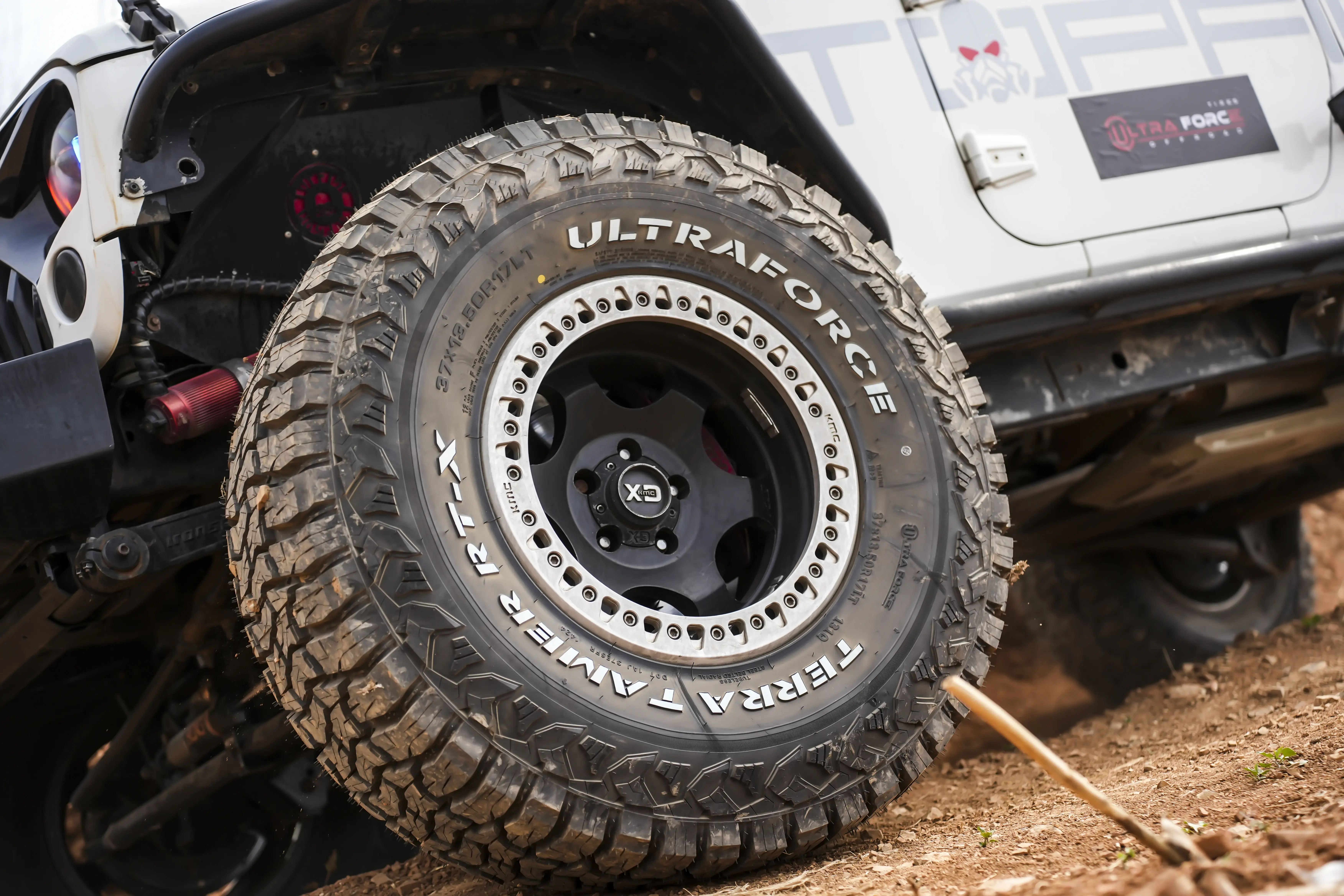
Conclusion
Off-road tires that are good on-road represent the pinnacle of tire engineering, offering a harmonious blend of ruggedness and refinement. As the demand for versatile vehicles grows, so does the innovation in tire technology, providing drivers with reliable options that do not compromise on safety, comfort, or performance. Whether you're navigating city streets, cruising on highways, or conquering off-road trails, these dual-purpose tires ensure you're always ready for the journey ahead. Investing in quality dual-purpose tires is a smart decision for any driver seeking the best of both worlds.
